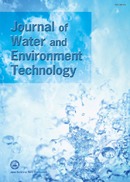All issues

Volume 7 (2009)
- Issue 4 Pages 215-
- Issue 3 Pages 155-
- Issue 2 Pages 43-
- Issue 1 Pages 1-
Volume 7, Issue 1
Original Papers
Displaying 1-4 of 4 articles from this issue
- |<
- <
- 1
- >
- >|
Original Paper
-
Yuki KAMIMOTO, Yoshiaki KISO, Tatsuo OGUCHI, Toshiro YAMADA, Jung-Yong ...2009Volume 7Issue 1 Pages 1-8
Published: 2009
Released on J-STAGE: April 03, 2009
JOURNAL FREE ACCESSN,N-Dimethylformamide (DMF) is a water-miscible polar solvent that is used in a wide variety of chemical industries. In Japan, 0.668 × 106 kg·y-1 of DMF is discharged to the sewerage system and is ranked highest in the PRTR (2006). In this work, a bench-scale mesh-filtration bioreactor was employed for aerobic biological treatment of DMF. Synthetic wastewater containing 1000 mg·L-1 of DMF was fed into the reactor at 5 or 2.5 days of hydraulic retention time (HRT) and at a volumetric loading rate of 0.125 or 0.25 kg-DMF m-3 d-1; the pH of the reaction mixture was not controlled. Performances in removal of dissolved organic carbon (DOC) and nitrogen were examined. Although the pH of the reaction mixture decreased to around 3, DOC removal remained at more than 98%, nitrification was complete, and about 45% of total nitrogen was removed. The rates of DMF decomposition, nitrification, and denitrification were evaluated by batch experiments, with the result that for these three biological reactions the sludge in the reactor showed significant activities even at pH 3. These results suggest that the sludge contained acidophilic nitrifying bacteria.View full abstractDownload PDF (263K) -
Asa Miura, Eisaku Shiratani, Koji Hamada, Tadayoshi Hitomi, Ikuo Yoshi ...2009Volume 7Issue 1 Pages 9-17
Published: 2009
Released on J-STAGE: April 03, 2009
JOURNAL FREE ACCESSThis study examined the ability of charcoal to remove organic matter, nutrients and heavy metals from agricultural drainage. Water treatment equipment containing wood charcoal was installed in a test paddy field. Concentrations of total organic carbon (TOC), total nitrogen (TN), total phosphorus (TP) and heavy metals (Cr, Fe, Zn and Pb) in water samples taken before and after passing through the equipment were analyzed. The equipment was installed simply at the outlet in the test field and removed environmental load substances during a contact time of more than one hour. The reduction rates of TOC and TN ranged from 20 % to 40 %. The reduction rate of TP ranged from 20 % to 90 %. The reduction rates of metals (Cr, Fe, Pb) ranged from 23 % to 62 %. These results suggest that charcoal can be used in water treatment equipment to treat paddy field drainage water.View full abstractDownload PDF (258K) -
Kazuo TOMIIE, Yasuhiro IWASA, Kaori MAEDA, Michiko OTSUZUKI, Tsutomu Y ...2009Volume 7Issue 1 Pages 19-28
Published: 2009
Released on J-STAGE: April 03, 2009
JOURNAL FREE ACCESSNitrate-nitrogen (NO3-N) contamination in groundwater has been worldwide concern, and especially it is a critical issue for the region depending on groundwater for water supply. Kumamoto city depends on only groundwater for all of water supply, however, lowering groundwater level and increasing NO3-N concentration have been revealed recently. In this study, the current situation of NO3-N contamination in the groundwater of Kumamoto city was investigated. Nitrate-nitrogen was detected in the range from 0.2 to 5.8 mg/l in the groundwater of deep wells at 22 points out of total 30 sampling points including drinking water resource. The NO3-N concentration was closely related to the location of wells and groundwater flow. The upward tendency in NO3-N concentration was recognized at a number of wells for recent 20 years, and it was considered due to the agricultural activity in the corresponding and their upstream areas.View full abstractDownload PDF (682K) -
Khondoker Mahbub Hassan, Kensuke Fukushi, Fumiyuki Nakajima, Kazuo Yam ...2009Volume 7Issue 1 Pages 29-41
Published: 2009
Released on J-STAGE: April 03, 2009
JOURNAL FREE ACCESSA large number of drinking water treatment units have been installed in many regions adopting the technique of arsenic removal through adsorption and co-precipitation with the naturally occurring iron in groundwater and subsequent sand filtration. This study revealed the consequence of the organic matter inclusion on the arsenic treatment process for drinking water. Laboratory investigation confirmed that the organic contamination in the treatment process impeded the arsenic removal efficiency depending on the types and concentrations of the organic matters. The impact of organic matter contamination on the arsenic removal efficiency was almost immediate and the autoclaved examination showed similar results. Nevertheless, the bioleaching of arsenic, 93 μg/L, from the accumulated sludge in the filter bed was observed under the inoperative condition, for 7 days, of the treatment unit. However, in the control observation (using organic matter plus antibiotic) the effluent arsenic concentration was found to be less than 30 μg/L. The effluent iron concentration in the bioleaching process was not worth mentioning and found to be less than 0.22 mg/L. In this study, the chemical and biological consequences of the organic matter contamination on the arsenic removal practice is elucidated, which might contribute in designing safe options for drinking water.View full abstractDownload PDF (252K)
- |<
- <
- 1
- >
- >|